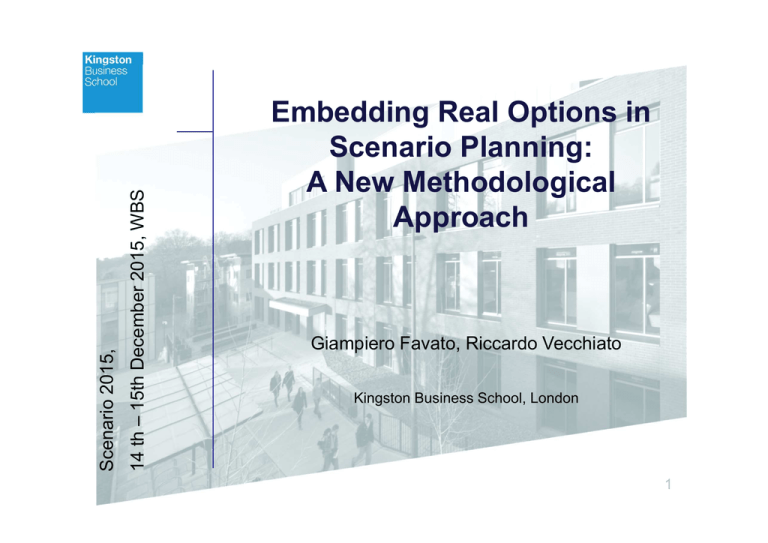
14 th – 15th December 2015, WBS
Scenario 2015,
Embedding Real Options in
Scenario Planning:
A New Methodological
Approach
Giampiero Favato, Riccardo Vecchiato
Kingston Business School, London
1
Resarch Aim
This paper aims to bridge the gap in
the integration of scenarios and real
options by:
1. Developing an intuitive approach
to real option evaluation;
2. Combining it with scenario
planning;
3. Testing the new model on a real
capital investment decision.
2
Integrating scenarios and
real options: rationale
• Real options involve the application of financial options
theory to investment decisions on real assets (McGrath
et al., 2004; Tong and Reuer, 2007)
• Real option theory emphasizes that many initial
investments create relevant opportunities for follow-on
investments (Dixit and Pindyck, 1994; Trigeorgis, 1996;
Krychowski and Quelin, 2010).
• Real options might help decision makers to better
understand the impact of the alternative patterns of
evolution of key drivers of changes
• Real options are likely to quantify the financial
implications for the organization of scenarios, by
providing tangible and reliable measures in terms of
cash flows and profits
3
Integrating scenarios and real
options: key issues
• No evidence is provided as how to bridge the gap between
the qualitative approach of scenarios and the quantitative
approach of real options (Miller and Waller, 2003; Ram and
Montibeller, 2013)
• Decision makers do not have the mathematical skills
necessary to use these models comfortably and
knowledgeably (Borison, 2005; Triantis, 2005)
• The key issue of volatility: the estimate of variance of
returns is the Achilles heel of the Black & Scholes’ model.
4
Components of the model:
classical 2x2 matrix
5
Real options: the pay-off method
(Collan et al., 2009)
• “worst” case scenario (Driver A: -; Driver B: -)
• “best” case scenario (Driver A: +, Driver B: +)
• “base” scenario (combining the ‘ + - ‘ and ‘ - + ‘ scenarios)
INVEST IF PAY-OFF VALUE > REQUIRED CAPITAL
6
Intuitive visualisation of our model
Legend:
a
probabilised value
of base case
α
difference of absolute
values of base and worst
case
β
difference of absolute
values of best and base
case
(a+β) value of best case
(a-α) value of worst case
1
0
E(A+)
© Registered
copyright 284699314
All rights reserved
highest possibility
lowest possibility
Pay-off Value
7
Research Methodology
• Action research
• One of the authors was directly involved in the
application of the method as he served as
advisor to the Board of IDEa at the time of a
critical investment decision for the clinical
development of a new drug
• This privileged viewpoint allowed us to get
access to primary data and to provide a
detailed description of the application of the
method and its outcomes
8
A real investment decision:
IDEa-001
• A Biotech Firm is developing a novel treatment for
Follicular Lymphoma: IDEa-001
• IDEa-001 has successfully cleared Phase I
• An additional investment of $10.2 millions required to
progress to Phase II of clinical development
•
•
•
Phase I: discovery and preclinical testing, where
specificity of antitumor activity and toxicity are initially
tested in animal models
Phase II: carrying out studies in patients of selected
tumor type to estimate efficacy compared to historical
control and confirm optimal therapeutic dosage
Enlarged Phase II/Phase III: larger studies aimed at
head-to-head comparison of the drug in development with
the then-best-available therapy.
9
Possible scenarios for IDEa-001
at the end of Phase II
Allowable scenarios
at the end of Phase II trials
Efficacy
3rd line FL patients
in good performance
status (75%)
Peak share: 15%
Price: 100k USD
+
2nd line FL patients
Peak share: 15%
Price: USD 75k
GO TO Phase III
GO TO Phase III
Safety
No clinical benefits
foreseeable.
Highly unlikely to
receive regulatory
approval.
3rd line FL patients
in poor health status
(25%)
Peak share: 50%
Price: 100k USD
ABANDON
DEVELOPMENT
GO TO Phase III
-
Standard of care
+
10
Inputs to the DCFs stemming
from the four allowable scenarios
INPUTS TO Discounted Cash Flow
(DCF) model
WORST
SCENARIO
BASE CASE
safety -;
response rate +
36,727
36,727
1.5%
Abandon
development
1.5%
Third line
Patients treated (% of total FL patients)
IDEa-001 peak share
First approval & launch
Patent expiration
Net effective price per patient
-
Probability rate of marketing approval
Follicular Lymphoma (FL) patients in US
and 5 major EU Countries
Annual growth rate
Indication (s)
R&D investment to complete PII
Incremental R&D investment to
complete development
Annual cost of pharmaco-vigilance
Annual incremental fixed capital
investments
BASE CASE
safety+;
response rate
36,727
BEST
SCENARIO
1.5%
Second line
10.5%
15%
Year 3
Year 16
$100,000
1.5%
Third line,
patients in
poor status
3.5%
50%
Year 3
Year 16
$100,000
-
50%
50%
50%
$10.2 mill
-
$10.2 mill
$44 million
$10.2 mill
$44 million
£10.2 mill
$44 million
-
$2 mill
Up to $2 mill in
Year 5; $1 mill
thereafter
revenues
20%
$2 mill
Up to $2 mill in
Year 5; $1 mill
thereafter
revenues
20%
10%
5%
35%
12%
10%
5%
35%
12%
Basis for probabilised costs
Cost of Goods Sold
-
$2 mill
Up to $2 mill in
Year 5; $1 mill
thereafter
revenues
20%
Sales & Marketing costs
Other operating expenses
Effective tax rate as % of EBIDTA
Discount rate
-
10%
5%
35%
12%
36,727
33%
15%
Year 3
Year 16
$75,000
SOURCES
Globocan IARC WHO
www.globocan.iarc.fr
Globocan IARC WHO
IDEaTION strategic assessment
IDEaTION estimate
IDEaTION estimate
IDEaTION estimate
IDEa-001 IND filing
IDEaTION targets based on the inverse
correlation between incidence and price
Global Data attrition analysis
www.globaldata.com
IDEaTION estimate
IDEaTION estimate
IDEaTION estimate
IDEaTION estimates of capital required
to scale-up and to maintain supply after
approval
Probability-adjusted revenues
IDEaTION estimate based on small scale
PI manufacturing costs
Global Pharma: biotech industry average
Global Pharma: biotech industry average
IDEaTION estimate
Global Pharma (+4% illiquidity premium)
11
Graphical representation of IDEa-001’s
real option value of Phase II investment
Real Option price: $10.2 mill
(cost of PII development trials)
No clinical benefits
foreseeable.
Highly unlikely to
receive regulatory
approval.
ABANDON
DEVELOPMENT
WORST
$0 mill
3rd line FL patients
60% probability
response rate +
40% probability
safety +
Price 100k USD
GO TO P III
BASE
$11.8 mill
2nd line FL patients
Peak share: 15%
Price: USD 75k
GO TO P III
BEST
$78.9 mill
Real Option value= $21.0m
The real option value
obtained with the pay-off
method was absolutely
comparable to the
option value calculated
through Black & Scholes
formula, showing a
negligible difference of
1.3%.
12
Advantages
• The pay-off method quantifies the value implications
for the organization of the 2 x2 scenario matrix
• The pay-off method is based on fuzzy
distribution of possibilities. It does not require
to calculate volatility.
• The application of the pay-off method is consistent
with the main objective of scenarios
• The two techniques – deductive scenarios and payoff method – speak a language familiar to
management
• Together, they are likely to improve the
understanding of uncertainty and competitive
dynamic environment
13
Conclusions
• Our model can be extended to virtually ant strategic
investment decisions, by simply changing the key
variables to use as the axes of the 2 x 2 scenario
matrix (e.g., the market share and the market size of a
new product, or maturity and interest rate of financial
instruments)
• The model can be extended to other traditional
domains of application of real options, such as
mergers and acquisitions (Krychowski and Quelin,
2010) and IPO pricing
• The pay-off method is being developed from the
current triangular approach to a trapezoidal approach
14
14 th – 15th December 2015, WBS
Scenario 2015,
Embedding Real Options in
Scenario Planning:
A New Methodological
Approach
Giampiero Favato
g.favato@kingston.ac.uk
Riccardo Vecchiato
r.vecchiato@kingston.ac.uk
15





